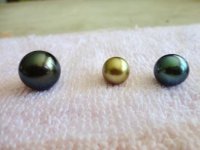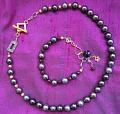The 19th and 20th century pearl shell divers of Polynesia were fortunate if they found a fine natural pearl in one of every 15,000 oysters they plucked from the sea for the button and inlay trade. French Polynesia, in 1999, exported 8.2 tons of Pacific “black” pearls from the black-lipped pearl oyster, valued at around US$200 million. All came from scores of pearl oyster farms, which are not only diluting the French territory’s dependence on aid and military spending, but are reviving island communities depopulated by the lure of town life in the capital, Papeete.
Pearl farming research began in French Polynesia in 1963 and gem quality pearls were first produced in 1965. Exports, of only two kilos, began in 1972. In the Cook Islands, pearl farms were established at the atolls of Manihiki and Penrhyn in the 1980s. By 1998, Cook Islands exports were officially estimated at NZ$5 million — 84 percent of total exports. Since Manihiki’s production was estimated at 250,000 pearls worth NZ$12million, actual exports are much underreported — a figure expected to rise to NZ$18 million by 2003.
The first Marshall Islands harvest came in 1996, with the best of the crop sold to Harry Winston’s, a New York Fifth Avenue jeweler. The first Solomon Islands cultivated pearls were auctioned at Sydney last October. Tonga, Fiji, Kiribati, Vanuatu, the Federated States of Micronesia and Papua New Guinea are endeavoring to climb board the pearl farming business.
In Papeete, the specter of competition from other Pacific islands countries and the spectacular growth of its own industry is prompting French Polynesia’s pearl merchants to ask whether over-production and saturation of the market could become the cutting of their throats. Didier Sibani, of Maison Sibani Perles, one of the industry’s biggest dealers, doesn’t believe so. Traditional Asian markets are mature, but the markets of America and Europe are untouched, he says.
Neil Sims, whose Honolulu company, Black Pearls Inc., grew and took Marshall Islands pearls to the New York market, is also optimistic. “The production by other Pacific islands will not even begin to impact the Tahitian pearl market for at least 10 years, probably 20,” he says. “Any risk of over-production, for the foreseeable future, lies solely in the Tuamotu lagoons (of French Polynesia).”
“Black” pearls mean pearls grown in the black-lipped pearl oyster, Pinctada Margaritafera. They can be green, blue, silver, violet and other colors. Value depends on size, lustre, symmetry, lack of flaws and rarity of color. In a simple gold setting a single pearl necklace or a pair of earrings fetches typically US$1,000-US$2,000. Top prices for good necklaces are around US$50,000. Australia, French Polynesia, Indonesia and Japan are the main cultured pearl producers.
Apart from the overwhelming economic gain that the experience in French Polynesian and the Cook Islands shows, the industry can become an anchor for the survival of isolated outer island communities. In Oceania’s archipelagos the trend is for small islands to become severely depopulated by the shift of people to mainland towns in search of work, education and lifestyle improvement.
In French Polynesia, the former migration trend from the outer islands of the Gambier and Tuamotu groups to Tahiti has been reversed. Between 1988 and 1996 the population of the Gambiers rose by 75 percent. In the same period populations in individual islands grew by 23-31 percent (Takaroa and Takapoto) to as much as 133 and 191 percent (Ahe and Kauhei). Living standards also rose noticeably.
But in a Pacific Community Pearl Oyster bulletin, editor Neil Sims suggests that “we might need to re-evaluate our perceptions as to how pearl culture happens, and who benefits most.” The French Polynesian and Cook Islands models of numerous small family farms scattered across atolls have been praised as an ideal form of rural development. But, Sims asks: “Is this breathless admiration based on any reality?” In the Tuamotu islands, according to economics professor Bernard Poirine, the expansion of pearl production in the past 10 years was not accompanied by a corresponding increase of employment.
This was primarily because existing farms became larger, more mechanized and more efficient. The trend in French Polynesia, Sims says, is for bigger farms, with new ones established in previously unfarmed lagoons as mainly concessions bought by larger farmers with the capital and support to work in remoter areas. One operator, Robert Wan, now controls more than 50 percent of the industry and the largest five produce 75 percent of French Polynesia’s output.
Sims says an issue is whether governments should regulate the industry so that more people benefit from it or “just get out of the way and allow market forces to move at will?” Another is whether there should be limits on black pearl production? Could limits even be realistic?
“The small-scale, extended family cooperative model of pearl farming has always been the darling of development. It appears to offer a suitable profit-incentive, it is readily applied and seems to fit in well with the atolls’ socio-cultural milieu.” But in French Polynesia more than US$5 million in small pearl farm loans remain unpaid. Small farmers are becoming less competitive in the face of increasing production, falling pearl prices and the trend towards the vertical integration of production, auctions and retailing.
“A plethora of Polynesians with pockets full of pearls can lead to further market instability,” he says. However, as Japan shows, cooperatives through which small farms obtain spat, or tightly managed marketing, appear to have been successful and now have a crucial role in French Polynesia. Sims says that in the Marshall Islands his own company, Black Pearls of Micronesia, is applying the old plantation agriculture model, used more recently for shrimp farming, to expand pearl farming beyond one large nucleus farm.
“The nucleus farm provides those services and support which best befit a large, capitalized operation: the hatchery, training and extension, bulk purchase of material and supplies, provision of seeding technician services and greater marketing clout. The smaller satellite farms are independently operated and provide those attributes best befitting locally-owned operations: lagoon and land access, boats, labor, local knowledge. We’ll let you know how it goes,” he says.


